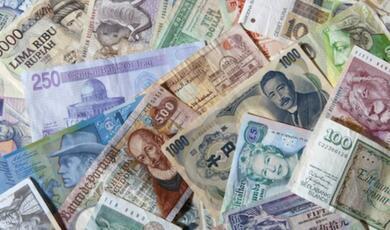The External Financing Position
Share
- Details
- Transcript
- Audio
- Downloads
- Extra Reading
For most of the period since we have had records, the UK has held a positive net international investment positions versus the rest of the world. But the UK is now a net debtor versus the rest of the world. We shall examine the reasons for this extraordinary reversal and what it means for the exchange rate and whether it implies constraints on the current account, and ultimately on output growth.
Download Transcript
27 April 2017
The UK’s External Financing Position
Professor Jagjit Chadha
“First, as to this that no gold or silver comes into England, but that which is in England is carried beyond the sea, I maintain that it is because the land spends too much in merchandise, as in grocery, mercery and peltry, or wines, red, white and sweet, and also in exchanges made to the Court of Rome in divers ways. Wherefore the remedy seems to me to be that each merchant bringing merchandise into England take out of the commodities of the land as much as his merchandise aforesaid shall amount to ; and that none carry gold or silver beyond the sea, as it is ordained by statute. . . . And so meseems that the money that is in England will remain, and great quantity of money and bullion will come from the parts beyond the sea.”
Richard Leicester, 1381
Introduction
For much of the time since the Renaissance, arguably up until the publication of Adam Smith’s Wealth of Nations and David Ricardo’s development of trade theory with his development of comparative advantage, the dominant economic thought was Mercantilism. The idea essentially that the state through the control of monopolies and restrictive trade practices ought to target trade surpluses so that gold or bullion could be retained or hoarded as a measure of economic progress. We can even think of this objective as a way of showing that economy was increasing its claims on resources because under a metallic standard, bullion was both a universal store of value and unit of account and paper backed by it was a means of payment.
The need for a country to have a surplus is an ancient imperative. Perhaps like the need to store food for the cold winter. Surpluses are good and associated with times of plenty. Deficits are obviously bad and stir up emotions of need and reliance on others. If I am in deficit then I owe someone something or worse still I lose my independence. In economics, surplus might refer to many quantities: the government spending and taxation plans; the household balance sheet; or firm’s profits. But in this lecture we will concentrate on the surpluses and deficit as they relate to a country’s external account with the rest of the world, whether it imports more than it exports.
So we shall see if we can judge whether the trends are problematic in the UK. At face value the deterioration, itself a value-laden term, may suggest that we are increasingly unable to export sufficient quantities to pay for our imports. To start with let us get to the basics as to what the causes of those trends may be. We shall see that there are domestic and global explanations for the deterioration in the current account.
The Current Account
Let us first start with the country’s balance of payments that record a country’s international transactions. The current account measures the exports of goods and services to which we add net receipts of international income from interest paid or received on foreign assets or liabilities and any remittances or foreign aid. The capital account measures all asset transactions with overseas entities. The capital and current accounts add to zero. And a useful measure sometimes is the so-called basic balance which adds the current account to long term capital flows.
In the immediate post-war period when the economy was under many forms of capital and import and export controls, the current account was more often in surplus than deficit. There was a structural change in 1972/3 following both the abandonment of Bretton Woods and the first OPEC oil price shock, the UK current account went into deficit. And apart from a couple of years in the early 1980s, there has been a structural deficit ever since. Until 2011 the patterns in the current account were dominated by the trade balance in goods and services but there has been a marked deterioration in international income receipts, particularly in investment income and remittances.
The current account has been negatively associated with output over the business cycle, which offer some casual succour. In the sense that deficits indicate an economy in expansion and a surplus would indicate recessions. Naturally when we turn to the cyclical frequency we do not capture well structural trends. But that said there are two competing thoughts for why the current account and activity might be negatively related. The former is tied up with ideas of capacity constraints in an expansion. So that in an upswing when demand in the economy starts to use up spare capacity there is a need to import from abroad leading to a current account deficit. This process might be accompanies by increasing domestic wage pressure and a move along the Phillips curve. And was a popular explanation for the Stop-Go cycles of the immediate post war period. Indeed I shall return to it in the penultimate section in its original Salter-Swan form.
The more modern approach that followed the abandonment of capital controls in 1979, is that the current account is the analogue of the ideas we looked at on consumption where households facing a richer future rather than increasing consumption when they are richer borrow from it today and adopt a stable paths for consumption. We can then interpret current account deficits in an expansion as simply borrowing from abroad to build a richer future. The persistence of the current account deficit is though something of a problem for the theory as it suggests that we are continually building more and more for a richer future.
Savings and Investment (again)
So many problems in economics come down to the question of the point at which savings and investment equal each other. In a closed economy or in the world as a whole savings will equal investment with the interest rate adjusting to bring about an equivalence in household and firm plans. Indeed even if we add in the government sector, which may act to distort private sector choice by funding government consumption through taxes, savings will still equal investment.
When we open the question up to an open economy, if the world interest rate is below that which clear the domestic market for savings, then domestic investment can exceed domestic saving with a current account deficit representing the supply of investment from abroad. Indeed given a current account deficit should the supply of savings in the rest of the world increase, the world interest rate will tend to fall and lead to an even larger current account deficit in the UK. The secular pattern of current account deficits in the UK may be well explained by the position of our domestic savings and investment schedules relative to those in the rest of world.
Furthermore a well-known puzzle in international economics foresaw this kind of structural story. Feldstein-Horioka (1980) found that the level of domestic savings and investment in a country were highly correlated implying that capital mobility might be not very high. If capital was highly mobile we would observe more of a disconnect between levels of investment and saving. But in a world of high levels of capital mobility this explanation seems unlikely. And so what it more likely is that if certain countries increase savings, that will tend to reduce world real rates and so bid in more investment leading to a positive correlation between savings and investment. We will this possibility echoed when we look at the stock of UK external assets and liabilities.
The International Investment Position
The accumulated flows from the current account balance give us the net international investment position for a country. The stock of foreign assets held versus the stock of foreign claims on domestic assets is a more important constraint than the current account alone that reflects the net flow of these assets in any one year. The current account might be considered to be akin to a football team’s result in any one match and the net international investment position more akin to the league position. The change in the international investment position represents the current deficit plus any valuation effects of the assets and liabilities and any change in the exchange rate.
Over the past 20 years the net international investment position has been negative apart from 2008 and 2016 when large exchange rate depreciations changed the relative prices of foreign currency-denominated assets versus sterling-denominated liabilities. Broadly speaking the positive balances on FDI have not quite matched the negative balances on portfolio and other investments. Rather like savings and investment, the value of assets and liabilities tend to follow each other in magnitude. With the net investment position relatively small compared to the magnitudes. The international balance sheet was around twice GDP some 20 years ago but now around six times GDP. We are highly geared; internationally speaking.
This continuing increase in the magnitude of assets and liabilities and any persistence in current account deficits would tend to have a number of implications. First valuation changes at home or aboard might easily lead to abrupt changes in the net investment position. Secondly, there may be an increased tendency for the exchange rate to jump in order to bring about a sequence of trade surpluses or deficits to ensure that the investment position tends to balance. Sterling, in particular, tends to have occasional jumps that seem to correct problematic developments in the net international investment position. An interesting side point as well is that the net investment position even if in deficit may generate positive flows for the UK, if the returns on assets are higher than the payments due on liabilities. For much of the period since 2000, the interest paid on sterling liabilities has been lower than the returns from overseas assets so the flows from the net international position have been negative.
And so even though we seem to have a worrying stream of current account deficits, a combination of exchange rate changes, interest rate returns and valuation effects means that the net international investment position has a life of its own. The accumulated current account simply does not particular explain the net international investment position.
The Exchange Rate and Adjustment
Let us see if we can bring together our observations to understand the jumps in the UK exchange rate. We can start with the Salter-Swan approach to domestic and internal balance. Trace a locus that says as we increase domestic demand or absorption of goods, we need an appreciated exchange rate so that there is an incentive to switch goods to the domestic production sector. This is because at a higher exchange rate prices in the traded goods sector are cheaper and less attractive to producers. If the exchange rate is too high for a given level of absorption there will be some unemployment and if it is too low, there will be some inflation.
For external balance to obtain, for higher levels of absorption we need a depreciated exchange rate so that there is more of an incentive to produce goods in the traded sector. If the exchange rate is too high for a given level of absorption, then there will tend to be a current account deficit and it is too low then we can expect to observe a current account surplus. At the points of intersection, the economy is at full employment and in external balance. And in each of the quadrants we can observe four types of economy: unemployment-current account deficit; inflation- currency account surplus; inflation-current account deficit and unemployment-current account surplus.
If the UK has both unemployment and a current account deficit then an exchange rate depreciation may help get to balance. Last year’s exchange rate depreciation may thus have been very helpful as would help to eliminate the current account deficit and even bring about an inflation. But if the decision to leave the European Union does itself shift the loci, we may find after a short period of inflation no change in our overall structural external position.
Conclusion
The current account deficit will continue to be a question for debate. The old question of whether domestic absorption “causes” the current account or whether the availability of foreign capital “causes” the current account is not simple to answer. Because the outcome, the current account deficit, is the result of domestic and overseas preferences and the structure of the economy it is not really possible, in general, to talk in terms of causality. The biggest concern from the external position is that it has led to a negative net investment position and that overall size of the external balance sheet dwarfs domestic output several times over.
© Professor Jagjit S. Chadha, April 2017
References
Chadha, J.S., N. Janssen and C. Nolan (2001), "Productivity and Preferences in a Small Open Economy", Manchester School, 69, 57-80.
Feldstein, M., and C. Horioka (1980): “Domestic saving and international capital flows,” Economic Journal, 90, 314–329.
Obstfeld, M., and K. Rogoff (2000): “The six major puzzle in international economics: is there a common cause?” NBER Working Paper 7777.
Salter, W. (1959). "Internal and external balance: the role of price and expenditure effects." Economic Record, 35, 226-238.
Swan, T. (1960). "Economic control in a dependent economy." Economic Record, 36, 51-66.
Viner, J. (1937). Studies in the Theory of International Trade, London: George Allen and Unwin Limited.
[1]This overview lecture should be treated as a short introduction to many others' research. © Jagjit S. Chadha 2017.
This event was on Thu, 27 Apr 2017
Support Gresham
Gresham College has offered an outstanding education to the public free of charge for over 400 years. Today, Gresham plays an important role in fostering a love of learning and a greater understanding of ourselves and the world around us. Your donation will help to widen our reach and to broaden our audience, allowing more people to benefit from a high-quality education from some of the brightest minds.


 Login
Login







